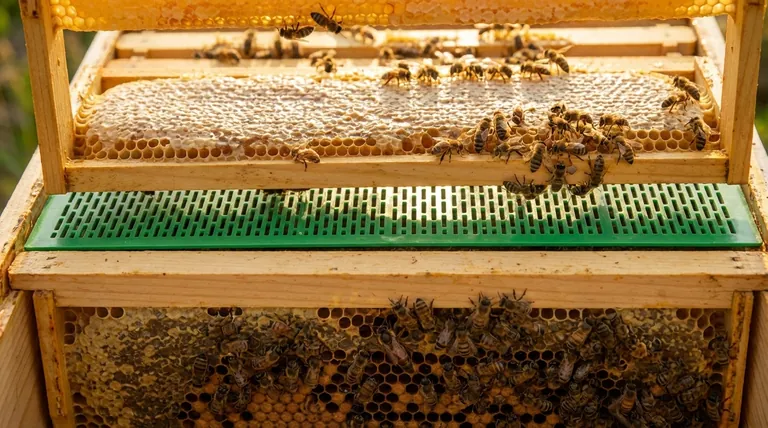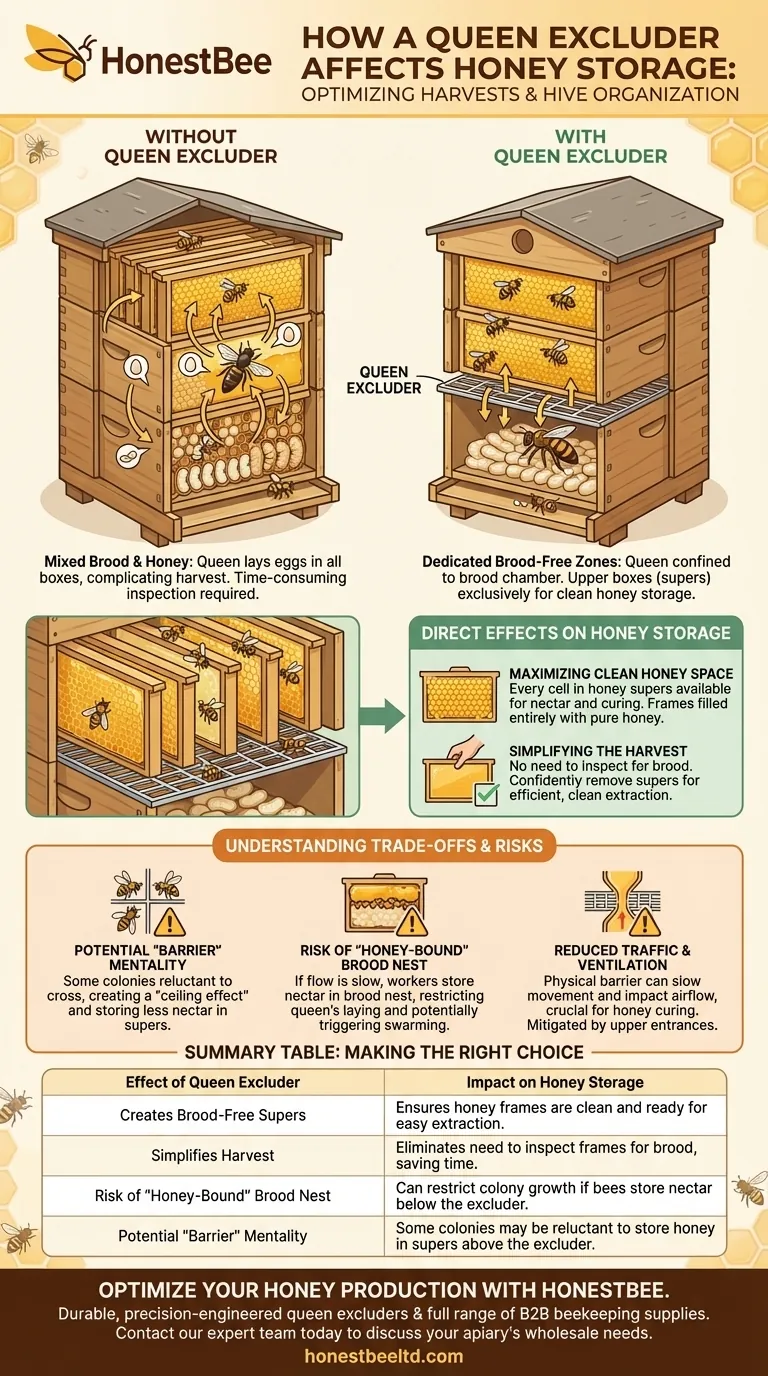In short, a queen excluder affects honey storage by creating a dedicated, brood-free zone in the beehive. It acts as a physical barrier that prevents the larger queen from moving into the honey supers to lay eggs, ensuring those upper boxes are used exclusively for storing honey. This simplifies the harvest and results in cleaner honey.
A queen excluder is a management tool that trades guaranteed brood-free honey for potential impacts on bee movement and hive morale. Its effectiveness is not universal and depends heavily on the specific behavior of each colony.

The Core Function: Separating Brood from Honey
A queen excluder is fundamentally a tool for hive organization. By controlling the queen's access to different parts of the hive, you dictate where specific activities occur.
How the Barrier Works
A queen excluder is a simple grid, made of plastic or metal, placed between the brood chamber and the honey supers.
The slots are engineered to be large enough for worker bees to pass through but too small for the larger queen and drones. This creates a selective barrier.
The Goal: Dedicated Honey Supers
The primary purpose is to ensure the honey supers remain free of eggs, larvae, and pupae.
This separation keeps the honey frames clean and makes the extraction process much more straightforward, as you don't have to worry about damaging brood cells.
Direct Effects on Honey Storage
Using an excluder has several direct consequences for how and where honey is stored in the hive.
Maximizing Clean Honey Space
By preventing the queen from laying eggs in the upper boxes, every single cell in a honey super is available for nectar storage and curing.
This leads to frames filled entirely with capped honey, which is the ultimate goal for a beekeeper looking to harvest.
Simplifying the Harvest Process
Without an excluder, a beekeeper must carefully inspect every frame before extraction to ensure no brood is present.
An excluder eliminates this step. You can confidently remove entire supers knowing they contain only honey, which significantly improves efficiency.
Understanding the Trade-offs and Risks
While beneficial for organization, a queen excluder is a controversial tool because it can negatively impact a colony's natural workflow and, in some cases, reduce the overall honey yield.
The "Barrier" Mentality
Some colonies are reluctant to pass through the excluder. This can create a "ceiling effect" where bees are hesitant to work in the supers above it.
Forager bees may see the supers as separate from the main hive, leading them to store less nectar than they would otherwise.
Risk of a "Honey-Bound" Brood Nest
If worker bees don't move nectar up through the excluder efficiently, they may store it in the brood chamber instead.
This is known as becoming honey-bound. It fills cells the queen needs for laying eggs, which restricts colony growth and can trigger swarming instincts—the opposite of the intended effect.
Reduced Traffic and Ventilation
The physical barrier, no matter how well-designed, can create a bottleneck. It slows the movement of bees between the brood nest and the supers.
This can reduce foraging efficiency and impact the colony's ability to ventilate the hive properly, which is crucial for curing honey. Some beekeepers mitigate this by adding a small upper entrance above the excluder.
Making the Right Choice for Your Hive
The decision to use a queen excluder depends entirely on your management style, the genetics of your bees, and your primary goals.
- If your primary focus is maximum, clean honey with an easy harvest: A queen excluder is a valuable tool for ensuring supers are brood-free and ready for extraction.
- If your primary focus is a more natural approach with minimal intervention: You may choose to forgo an excluder and manage the brood nest through careful monitoring instead.
- If your primary focus is managing an extremely prolific queen: An excluder is almost essential to prevent her from laying eggs throughout the entire hive, which can complicate harvests.
Ultimately, observing your specific colony's behavior is the best way to determine if a queen excluder is helping or hindering your hive's success.
Summary Table:
| Effect of Queen Excluder | Impact on Honey Storage |
|---|---|
| Creates Brood-Free Supers | Ensures honey frames are clean and ready for easy extraction. |
| Simplifies Harvest | Eliminates need to inspect frames for brood, saving time. |
| Risk of "Honey-Bound" Brood Nest | Can restrict colony growth if bees store nectar below the excluder. |
| Potential "Barrier" Mentality | Some colonies may be reluctant to store honey in supers above the excluder. |
Optimize your honey production with the right equipment. HONESTBEE supplies durable, precision-engineered queen excluders and a full range of beekeeping supplies to commercial apiaries and distributors. Our wholesale-focused operations ensure you get reliable, high-performance gear that supports healthy colonies and maximizes your harvest efficiency. Contact our expert team today to discuss your apiary's needs and place your wholesale order.
Visual Guide

Related Products
- High Performance Plastic Queen Excluder for Beekeeping and Apiary Management
- Professional Plastic Queen Excluder for Modern Beekeeping
- Wooden Queen Bee Excluder for Beekeeping
- Premium Wood Framed Metal Wire Queen Bee Excluder
- Plastic Queen Bee Excluder for Bee Hive Wholesale
People Also Ask
- When is the typical time frame for harvesting honey and removing the queen excluder? Optimize Your Hive Management
- Why don't all beekeepers use Queen Excluders? Balancing Honey Purity with Hive Productivity
- When should I remove my queen excluder? Timing is Critical for Winter Bee Survival
- When is the best time to place a queen excluder? Optimize Honey Production & Purity
- What happens if I don't use a queen excluder? Understand the impact on your honey harvest.



















